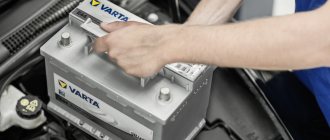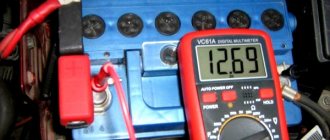Sooner or later, any car owner has a situation related to removing and installing the battery on the car. There are no hidden meanings or difficulties in connecting and disconnecting a car battery. Even a novice car enthusiast can do everything right. In this case, it is not necessary to contact car service specialists. If among the readers there are fragile girls or people who have limitations in lifting heavy objects, then it is better to resort to the services of a battery technician at a service station. If there are no such restrictions, and you can lift 15-18 kg without health problems, then we will figure out how to properly remove and install the battery on a car.
What you need to install the battery in the car
Before installing the battery, you need to prepare the necessary tools and consumables for installation work.
Depending on the car model, technical condition of the battery, and the condition of the terminals, the standard battery installation kit includes:
- open-end or socket wrenches for 10 and 13 (other options are possible);
- pliers;
- assembly knife (for stripping wires);
- sandpaper (fine and coarse - for cleaning contacts and terminals);
- special means for treating contacts and terminals in order to prevent their corrosion (you can use lithol, grease or silicone grease in the form of a spray);
- personal protective equipment (see next section);
- multimeter for monitoring battery charge voltage.
Safety precautions
The main dangerous factors when working with a battery are:
- the possibility of large currents flowing in the event of a short circuit, sparking and overheating of live parts (tools);
- aggressive chemical properties of the electrolyte;
- large battery mass.
Considering the above hazards, the following safety precautions must be observed when installing the battery:
- strictly follow the installation process;
- use work clothes made from natural materials;
- shoes should be hard (boots, work boots);
- Use rubber gloves and safety glasses as personal protective equipment (protection against electrolyte getting on the body and eyes in case of unforeseen circumstances).
When is it necessary to charge a new battery?
When is it necessary to charge a new battery:
- If the density of the electrolyte in the battery banks is less than 1.24 g/cm3. With this parameter, the battery charge level fluctuates around 80%. This is no less, it is quite possible to wait until 1.19 g/cm3 (50% charge), but it is better to bring the battery capacity to a fully charged state.
- If a test with a multimeter shows less than 12.4 V. 12.4-12.2 V is a normal indicator, a couple of hours at a minimum current is enough for a full charge. But 12 V or less means an almost “empty” battery, which may not even be enough for a trip to the store.
Advice! A car multimeter is a very useful thing; it is recommended that every driver take it with him.
Preparatory work
Before installing the battery in the car’s original location, it is necessary to carry out a set of preparatory work:
- Clean the normal installation location of the battery from dirt, dust, and foreign objects. If you decide to install a battery of higher power, then you need to make sure that the mounting dimensions match. Please note that during operation the battery must be well ventilated and cooled. Otherwise, it may boil, especially in the warm season. Therefore, you should not literally “shove” the battery under the hood.
- Check the battery voltage and electrolyte level (in the serviced version). The voltage measured with a multimeter should be between 12.6 and 12.9 Volts. If it is less than the lower threshold, the battery should be recharged. This is easier to do in stationary conditions than in a car.
If you are installing a used battery, it is advisable to check the density of the electrolyte. At a temperature of 25 degrees Celsius it should be in the range from 1.26 to 1.30 grams per cubic centimeter. To control density, you must use a hydrometer.
If you purchased a battery of questionable quality, you can check its starting current. This is done using a special loading fork. Many sellers make a control current measurement before transferring the goods to the buyer, and this is correct.
- Assess the quality of contacts and terminals. If necessary, they must be cleaned: first with coarse, then fine sandpaper. If it is missing, you can strip it with a knife. The starting current depends on the quality of the contact - this is one of the main characteristics of the battery.
Recycling an old car battery
Failed units are not installed in the car. They must be disposed of because toxic and harmful materials were used for their preparation.
Full or partial disposal is carried out by special organizations. They operate according to a proven scheme:
- Draining and neutralization of spent electrolyte.
- Crushing the body on special machines.
- Removing debris and metal residues from the lead-acid mixture.
- Lead separation and purification.
- Re-preparation of purified lead products.
Battery and running engine
The car battery can only be removed with the engine turned off. It is prohibited to dismantle the battery while the engine is running. And it is important to take this into account when we are talking about modern cars equipped with on-board computers.
Basic moments:
- When the engine is turned on, a charge is constantly supplied from the generator. When dismantling, the positive terminal hits the body, resulting in a short circuit. This can harm not only the generator, but also the entire wiring and on-board network.
- If the battery is disconnected without permission, a voltage surge occurs. Increased voltage affects the performance of the relay regulator, alarm system, and other components.
- The power source is turned off when the ignition is turned off.
- Dismantling is carried out in accordance with the requirements and standards that are recorded in the technical documentation.
Choosing a new car battery
It is prohibited to install a battery that has exhausted almost its entire working life. Therefore, you need to know how to choose a new power source.
The choice of battery, as well as the choice of a car, must be taken responsibly. When choosing a battery, you need to take into account the information recorded in the technical documentation. Manufacturers list all technical parameters and characteristics. Therefore, the selection will not take much time.
When viewing catalogs with modern units, you need to consider:
- Capacity. The nominal value for the new and “original” batteries must be the same. It is not recommended to purchase devices with large capacities.
- Current strength. The average value for a battery is about 480 A. Among the presented models, choosing a device with this parameter is not difficult.
- Polarity. Manufacturers supply car batteries with reverse and direct polarity. They connect differently.
- Dimensions of the device and terminals. Various manufacturing companies supply power supplies with thin, thick, and oversized terminals. But you need to take into account not only the dimensions of the car terminals, but also the design features of the power source and vehicle. After all, even minimal inconsistencies will complicate the installation process.
- Manufacturer. When choosing a manufacturer, you can be guided by the recommendations of the car manufacturer, advice from experts, and personal preferences.
- State. Appearance assessment is a mandatory step. The power source must not be deformed. It should not have cracks, chips or other damage.
- Checking the markings. The power source is marked with a number of symbols. The marking includes the type of battery, permissible temperature, capacity, polarity, and current value.
After selecting 2-3 models for subsequent installation of batteries in the car, testing is carried out and the final choice is made.
The new battery must be installed in the car in the same order as the previously used one.
Precautionary measures
Dismantling and installation of car batteries is carried out taking into account the rules:
- To work with electrolyte, you need to prepare thick rubber gloves and protective clothing. After all, the electrolyte contains sulfuric acid. Contact with this substance causes burns. To neutralize the acid, you will need baking soda. It needs to be prepared in advance.
- The alarm is turned off until the power supplies are replaced. After all, it can work at the most inopportune moment.
- The terminals and leads are treated with a special lithium grease. It helps minimize the likelihood of oxidation. The composition must be applied carefully.
- Before installation, the condition of the seals, housing, leads, and other elements is checked. Installation of damaged or leaking power supplies is not recommended.
- After installing the battery, the functionality of all systems is checked. If necessary, the main systems are restarted. Such precautions and safety are important to consider.
- It is prohibited to place metal structures and objects near the dismantled unit.
- It is prohibited to connect wires from the terminals. Such actions can cause a short circuit and failure of the restored battery.
- Do not turn the battery over. Electrolyte may leak through loosely closed plugs.
- It is prohibited to add electrolyte during the replacement process. Such actions are performed only when carrying out repair activities.
Battery care rules
Proper care of the plug-in power source will eliminate difficulties and problems for 2–4 years. Among all the rules, several deserve special attention:
- When the engine is turned off, you need to periodically check the strength of the fastening. Even minor displacements provoke vibration, which negatively affects the performance of the device.
- Oxide often forms at the terminal junctions. Anti-corrosion substances are used to remove it. They are easy to find in specialized stores.
- You should regularly check the charge level of the battery. Such actions can only be performed with the engine turned off. A voltmeter is great for checking.
- If the vehicle is not used for a long time, the battery should be moved into the house and the negative terminal should be disconnected.
- Periodically, the unit is cleaned of dirt, electrolyte drips, and other contaminants. For cleaning, it is allowed to use a clean rag or sponge.
The battery life depends on the correctness of the dismantling and installation process. Therefore, all rules and recommendations must be followed. After all, buying a new device is an expensive undertaking.
Useful videos about battery removal and installation
How to put a battery in a car
To avoid short circuits and damage to the vehicle’s electrical equipment, the battery should be installed strictly following the following sequence of work:
- Install the battery in its original place. Check that the polarity of the terminals corresponds to the plus and minus positions on the battery. When installing in the dark, you can use the embossed + and – markings on the battery. In addition, you should know that the positive terminal of the battery is thicker (19.5 mm) than the negative terminal (17.5 mm). Three-level protection against polarity reversal is not accidental. If you install the battery in reverse polarity, half of the fuses will burn out, the generator will fail, and there may be serious problems with the car’s electronics.
- Secure the battery to its original location using a bracket or bracket.
- Install a gas outlet on the battery, if available. A gas outlet is usually installed if the battery is located in the passenger compartment or trunk. It is designed to remove gaseous products of charge-discharge processes from the battery.
- Connect the terminals. Connection sequence:
- place the positive terminal first (in this case, if the key that secures the terminal comes into contact with the ground of the car, there will be no short circuit, since the negative contact is still disconnected);
- install and secure the negative terminal.
- Perform a test run of the engine.
- Treat contacts and terminals to prevent further corrosion.
Which terminal to put first on the battery: The positive terminal is connected first, and then the negative one. It is important not to confuse!
Why did the new battery turn out to be discharged?
Often, car owners, having purchased a new battery, are faced with the fact that the device is completely discharged. The reason for this is that the “battery” has been in the store or warehouse for quite a long time. As a result, an independent discharge of the battery capacity occurred. As a result, the longer the battery was left, the more it was discharged.
In order not to make a mistake, it is necessary to study the date of manufacture of the device. It is usually located on the packaging or on the body of the product itself.
Some unscrupulous car battery manufacturers claim that their devices are not subject to self-discharge. In fact, so far no company has managed to completely get rid of this problem, so a similar physical and chemical process will occur in any “battery” in any case. To avoid getting caught with a dead battery, you need to follow just a few recommendations.
What to do if the car won't start
If the engine does not start due to poor starting of the starter, you should check the quality of the contacts at the battery terminals, clean them again and connect them. If this does not help, check the connection of the negative terminal to the car body and engine frame. It is possible that during dismantling or installation work the contacts at these connections became loose.
This situation is possible if the car is equipped with a battery of smaller capacity or with a longer service life. In such a situation, you should replace the battery with a new one.
Failure to start the engine is possible due to software failures in the car electronics associated with the discharge or disconnection of the battery. In this case, you can try removing the negative terminal of the battery for 15 - 20 minutes, then reconnecting it.
If replacing the battery is associated with long-term parking or battery discharge as a result of leaving the ignition in the on position, malfunctions in the immobilizer system are possible. In such a situation, it is extremely difficult to start the engine without the help of a specialist.
Startup failure may be due to the car alarm triggering in abnormal mode. You can try to restart it according to the instructions.
Design and types of batteries
The rapid development of technology has also affected the field of car batteries. Gone are the days when only serviceable antimony batteries were available. Today, if a battery needs to be replaced, drivers have plenty to choose from:
- Lead-acid power supplies. The classic type of battery, consisting of a housing in which lead electrodes are installed and electrochemical fluid is filled. The electrolyte reacts with the electrodes when current is supplied to the terminals from an external power source and when a load is connected. The average service life of this type of battery is about 5 years.
- AGM batteries are an improved version of lead-acid batteries. The main difference is the presence of fiberglass wrapping of the electrodes, which prevents them from falling off. They are manufactured using maintenance-free technology and are installed mainly in electric vehicles.
- Gel batteries use a jelly-like electrolyte instead of a liquid electrolyte, which has an order of magnitude less fluidity. This allows you to operate the battery in an inclined position, up to vertical, without the risk of electrolytic fluid leaking.
- Traction batteries differ from the listed analogues in their greater power (currents up to 1000 A and voltage up to 96 V), which allows them to be used as a long-term power source for vehicles.
How to restore settings after connecting the battery
In some cars, after reconnecting the battery, the settings of the on-board computer, car radio, other electronic devices and additional equipment are reset. An error message may appear on the dashboard.
In this case, you need to connect the car to a diagnostic scanner, read and delete all errors. As a rule, errors associated with low voltage on-board network will then be deleted. Other settings, such as car radios, will have to be restored manually.
Still have questions about installing the battery or have something to add? Then write to us about it in the comments, this will make the material more useful, complete and accurate.











